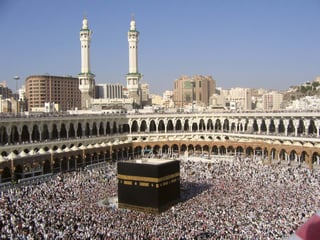
The Kaaba (Arabic: ٱلْكَعْبَة, romanized: al-Kaʿba, lit. 'the Cube', Arabic pronunciation: [al.ˈkaʕ.ba]), also spelled Ka'ba, Ka'bah or Kabah, sometimes referred to as al-Ka'ba al-Musharrafa (Arabic: ٱلْكَعْبَة ٱلْمُشَرَّفَة, romanized: al-Kaʿba l-Mušarrafa, lit. 'the Honored Ka'ba', Arabic pronunciation: [al.ˈkaʕ.ba‿l.mu.ˈʃar.ra.fa]), is a building at the center of Islam's most important mosque, the Masjid al-Haram in Mecca, Saudi Arabia. It is the most sacred site in Islam. It is considered by Muslims to be the Bayt Allah (Arabic: بَيْت ٱللَّٰه, lit. 'House of God') and is the qibla (Arabic: قِبْلَة, direction of prayer) for Muslims around the world when performing salah. The current structure was built after the original building was damaged by fire during the siege of Mecca by Umayyads in 683. In early Islam, Muslims faced in the general direction of Jerusalem as the qibla in their prayers before changing the direction to face the Kaaba, believed by Muslims to be a result of a Quranic verse revelation to Muhammad. According to Islamic history, the Kaaba was rebuilt several times throughout history, most famously by Ibrahim (Abraham) and his son Ismail (Ishmael), when he returned to the valley of Mecca several years after leaving his wife Hajar (Hagar) and Ismail there upon Allah's command. Circling the Kaaba seven times counterclockwise, known as Tawaf (Arabic: طواف, romanized: tawaaf), is a Fard (obligatory) rite for the completion of the Hajj and Umrah pilgrimages. The area around the Kaaba where pilgrims walk is called the Mataaf. The Kaaba and the Mataaf are surrounded by pilgrims every day of the Islamic year, except the 9th of Dhu al-Hijjah, known as the Day of Arafah, on which the cloth covering the structure, known as the Kiswah (Arabic: كسوة, romanized: Kiswah, lit. 'Cloth') is changed. However, the most significant increase in their numbers is during Ramadan and the Hajj, when millions of pilgrims gather for Tawaf. According to the Saudi Ministry of Hajj and Umrah, 6,791,100 external pilgrims arrived for the Umrah pilgrimage in the Islamic year AH 1439 (2017/2018 CE). From Wikipedia